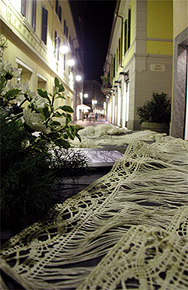7ª Biennial 2005
The Cantù International Lace Biennial seeks to do precisely this: keep the memory of this art with a glorious past alive, to adapt it to the present and project it into the future.
Born out of the passion and love for the art of lace on the part of a group of people (almost all women) who set up the Lace Promotion Committee, the Cantù International Biennial has aroused interest and expectation all over the world for years. It has now become a significant reference point for all those who desire to deepen their knowledge of the history, subjects, trends, materials and techniques of lace, not only from Cantù but more generally European, present both in the masterpieces produced in the past but also in many works from our time, thanks to the work of many anonymous lacemakers.
The number of visitors is increasing constantly (thirty thousand for the 2003 edition), and the presence of Italian and foreign schools is the sign of an attention and interest which not many people could have foreseen a few years ago.
In the 2005 edition the theme chosen for the Biennial is a topic closely linked to the history and manufacturing tradition of Cantù: the strong link which exists between the two most flourishing activities of the city and its area, lace and woodwork.
The Cantù area boasts an important tradition in the furniture sector, not only as regards the creation of fabulous items of furniture known all over the world, but also for the extraordinary creative and innovative capacity which it has displayed until recently. An important contribution to the training of generations of craftsmen and craftswomen has consisted of the presence of the School of Art applied to Industry, which was founded in Cantù in 1882 to teach design and draughtsmanship “with special application to the industries of the manufacture of wooden furniture and lace”. The opening in 1883 of the male sector aimed at furniture making and in 1888 the female sector for lace started a school institution which was subsequently transformed into the local State Art Institute, still active today. This school, thanks to qualified teachers of design, for more than a century has produced new styles and a common taste for craftsmen working with wood, lacemakers, designers and professionals in the furnishing sector in general.
There is a strong synergy between lace and furniture. Both arise from the “sign of man”, from the creativity which expresses itself when one approaches that particular sector of activity occupied with enhancing one’s dwelling and everything contained in it: furniture and furnishings, decorations, domestic linen and curtains. In time, from the fifteenth century onward, lace has decorated the home in many ways. One can think of the tablecloths, doilies or the panels which have graced our tables (and of which a rich collection was exhibited in the 2001 Biennial) or the curtains which thanks to the lacemakers’ skill have often become refined decorative tapestries.
The 7th International Lace Biennial aims at concentrating attention on the presence of lace in the home and on its relationship with furniture, not only from the point of view of use but also of design.
“Dream lace” is the theme of the historical section of the exhibition. The aim is to gather together a vast range of antique and modern lace works, manufactured in various European regions and coming from public and private collections, which have been used to beautify the home, with particular attention to its most intimate area, the bedroom. Alongside sheets, pillowcases, bedspreads and nightclothes, space has also been given to its wider use in home furnishing, to create curtains, tapestries and table centrepieces.
With the aim of better suggesting the idea of a dwelling, the lace will be “contextualised” by showing it on the furniture for which it was originally designed. It is not however desired to propose to visitors an evocative suggestion only from the aesthetic point of view, but to create an original and constant dialogue between the lace and the furniture which were both created in the Cantù area from the late-nineteenth century to the present. In this way the mutual influence and the evolution of the styles that they reflect may be better assessed.
Coinciding with the 7th International Lace Biennial there will be a Competition for a bobbin lace project, which has now reached its fifth edition, and as usual will be divided into two sections, one dedicated to tradition, the other to innovation. The initiative, aimed at traders and craftswomen in the sector, schools, associations, workshops and individuals, Italian and foreign, has as its theme the creation of a design for bobbin lace for clothing or contemporary textile furnishings for the bedroom.



